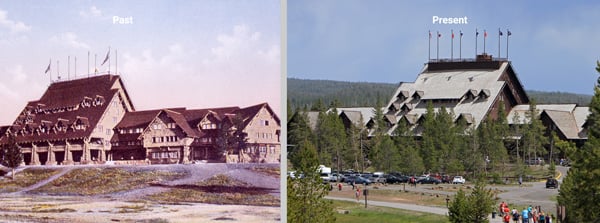The History of Yellowstone’s Old Faithful Inn
Old Faithful Inn
The Americans inspiring me during these strange times are those employing their full creativity and adaptability. Whether they are turning a child’s birthday party into a parade, moving their artwork from the gallery to the lawn, or making music together from four separate dorm rooms, they embody the spirit that will help our nation endure. Likewise, the endurance of the Old Faithful Inn, both as a physical presence and a cultural icon, springs from this same creativity and adaptability.
 The Inn’s foundation is the creative genius of architect Robert C. Reamer, combined with the business savvy of hotelier Harry W. Child. Constructed between June 1903 and June 1904, the builders used raw materials harvested from the local area. Adapting sixteenth-century technology they produced a modern wilderness log cabin with electricity, steam heat, and indoor plumbing.
The Inn’s foundation is the creative genius of architect Robert C. Reamer, combined with the business savvy of hotelier Harry W. Child. Constructed between June 1903 and June 1904, the builders used raw materials harvested from the local area. Adapting sixteenth-century technology they produced a modern wilderness log cabin with electricity, steam heat, and indoor plumbing.

There was risk – borrowing money from a railroad, inviting wealthy railroad travelers to engage in a multi-day stagecoach tour to marvel at the wonders of Yellowstone, and offering a rustic hostelry at the end of the day. The design drew inspiration from nature, but departed from the norms of the time. From its five-hundred ton massive rhyolite chimney to the whimsical tree house at its 76½ foot peak, the Inn both charms and welcomes.

A few years after it opened railroads and early automobilists embraced the idea to “See America First” – a campaign that successfully turned the tourist tide from Europe to our nation’s scenic wonders. The Inn’s first addition, known as the East Wing (1913-1914), grew out of this increasing interest. Its plain exterior and more generic plaster-walled interior, also the work of R. C. Reamer, reflect the practicality and speed in which rooms were added.

Soon the gasoline-burners replaced the horse-drawn stages. The independence-loving automobilists embraced the privacy of cabins, and the park’s lodges grew in popularity. But five railroads still served Yellowstone. So the park’s transportation company, also under H. W. Child, motorized. Child again engaged Reamer to adapt the Inn with a new auto-centered front entrance and more additional guest rooms (West Wing, 1927).

Adapting to increased visitation was not the only thing the Inn has endured in its 116 years. The ups and downs of tourist numbers during both World Wars and the Great Depression meant temporary closures. Physical threats from the 1959 Hebgen Lake Earthquake, the 1988 fire season, and dozens of harsh winters and heavy snow-loading have all been met. In the 1950s, and again in the 1970s, human decisions threatened the Inn’s future.
Since 1979, within the existing partnership between government ownership/oversight and concessioner financial commitments, the Inn has undergone three major periods of restoration/renovation – 1979-1988, 1992-1995, and 2004-2012. These included fire safety upgrades, two complete kitchen remodels, addition of bathrooms to guestrooms (except the original Old House), exterior re-shingling and re-roofing, and seismic stabilization. These necessary upgrades insure that we will enjoy this National Historic Landmark for decades to come.
Conceived with boldness and creativity, adapting to barrages from nature and cultural change, the presence and spirit of the Inn will endure.
For an in-depth history of the Old Faithful Inn read Weaver of Dreams: The Life and Architecture of Robert C. Reamer. This biography of a long-neglected American architect begins with his most famous creation, Old Faithful Inn. It introduces Robert Reamer fans to his other accomplishments and to the creative man who crafted them.
Ruth Quinn came to Yellowstone in 1990 as a mid-season replacement for a guest services agent at Lake Yellowstone Hotel. During her 26 years at the park she has served as an activity sales agent, step-on tour guide, housekeeping room attendant, housekeeping office assistant, housekeeping inspector, and a food & beverage office assistant. In summer, Ruth works as an Old Faithful Inn interpreter and in winter she is a human resources staff assistant. She is also the author of Weaver of Dreams: The Life and Architecture of Robert C. Reamer.
For more travel experiences to Beautiful Places on Earth™ available from Xanterra Travel Collection® and its affiliated properties, visit xanterra.com/explore.
Want to experience Yellowstone in-depth? See what makes Yellowstone National Park a great place to work for a season or longer!
Historical photos courtesy of NPS
Explore Yellowstone's History
- Explore Yellowstone's History